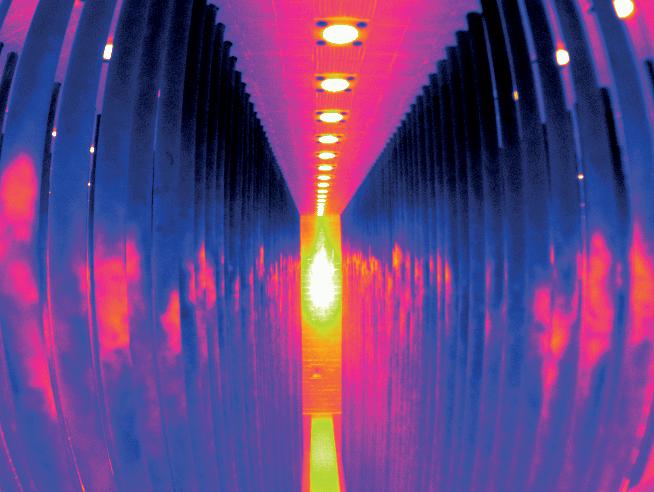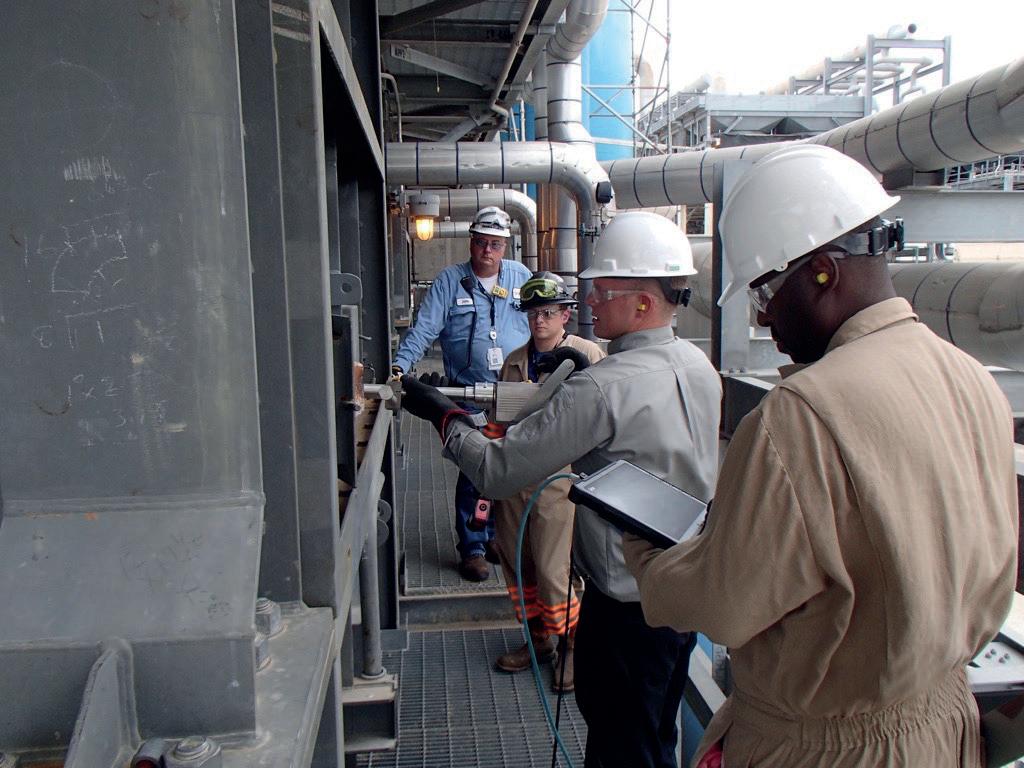
9 minute read
Blue H2 the right way
James Cross, AMETEK Land, UAE,
discusses how to improve reliability and productivity in steam cracker and steam methane reformer (SMR) operations.
Refineries and petrochemical industry operators find themselves in an ever-changing regulatory environment, where new global strategies for carbon emissions reduction are released frequently, often setting challenging targets and recommendations.
The US government has proposed a reduction in the country’s greenhouse gas emissions by 52% of 2005 levels by 2030 – a much shorter timeframe than its previous pledges. In summer 2021, the UK government issued its low-carbon hydrogen strategy built around blue and green hydrogen, committing to net zero emissions.
To meet these new economic and technical challenges, plant operators must make significant short-term improvements in efficiency, and radical changes in the longer term. The optimisation of the most carbon-intensive fired heater processes is the logical place to begin.

Fired heater processes and CO2
Steam methane reformers (SMRs), mostly used to supply hydrogen to refineries for ammonia/methanol production, and steam crackers for ethylene production, are two of the largest and most carbon-intensive refinery and petrochemical fired heaters.
It is estimated that SMRs emit around 800 million tpy of carbon dioxide (CO2), while steam crackers produce approximately 260 million tpy of CO2 emissions.
There is much focus on reducing CO2 emissions from these fired heaters by upgrading burners, changing tube/coil/refractory materials, and improving combustion efficiency. However, temperature monitoring and control can play an important role in improving process efficiency.
Steam reforming
SMR is used to produce more than 95% of the world’s hydrogen, typically using desulfurised natural gas, refinery off-gas, LPG, or naphtha as the feedstock.
This process works by preheating the feedstock, then mixing it with steam before it enters the primary reformer. At this point, the mixtures pass over a catalyst, reacting to produce hydrogen, carbon monoxide (CO) and CO2. The CO is shifted with steam to create additional hydrogen and CO2, and then pressure swing adsorption (PSA) is used to separate hydrogen.
The hydrogen generated is known as grey hydrogen when there is no carbon capture, usage and storage (CCUS) involved; however, when CCUS is used, blue hydrogen is produced.
SMRs emit CO2 in two main ways: producing it alongside hydrogen in the reforming reaction in the primary reaction furnace, and through combustion of the fuel. For the reformed gas, capturing CO2 is a relatively simple and low-cost process. However, post-combustion CO2 capture is more expensive because it needs to be separated from nitrogen.
Grey hydrogen production typically captures CO2 from only one of these sources, but blue hydrogen production captures CO2 from both. Using this method, SMRs can achieve a conversion efficiency of 74% and a CO2 capture rate of up to 90%.
Autothermal reformers (ATRs) can also be used together with CCUS to produce blue hydrogen. Technology licensors claim conversion efficiencies of 84%, with CO2 capture rates of 95% from this method. Heat for the reforming reaction is
supplied by combustion of the natural gas feed, so no separate fuel source is needed, as with SMRs.
Since there is only a single CO2 stream, using this process means that ATRs can achieve higher conversion efficiencies and CO2 capture rates than SMRs.
To remain competitive in the modern industrial environment, it is imperative that SMR operators improve their efficiency and CO2 capture in order to maximise plant profitability.
Primary syngas reformers
Primary syngas reformers are complex and important pieces of major equipment in refineries and petrochemical complexes, and they present unique and often frustrating challenges from the perspective of temperature measurement, reliability and optimisation.
It is also important to consider that refinery hydrogen producers have different objectives to other hydrogen producers – although demand for hydrogen as a fuel stock is certainly increasing at refineries around the world.
When optimising fired heaters, the primary goal is to run the tube outlet temperatures close to their design limits, while considering safety and minimising energy costs and emissions. By using industry-leading temperature and imaging technology, it is possible to operate with both higher yields and reliability.
Many refineries use the AMETEK Land Cyclops C100L and C390L for tube metal temperatures on high-temperature fired heaters, including primary syngas reformers used for hydrogen production, and for steam crackers used to produce ethylene. The Gold Cup reference pyrometer is utilised frequently to provide reference measurements for those devices, which are occasionally (but rarely) deployed on lower-temperature equipment.
AMETEK Land has also recently seen increasing demand from refineries for non-contact temperature measurement on lower-temperature fired heaters as efficiency improvements are sought. For example, crude oil preheaters heat products to between 330°C – 385°C, which is significantly lower than the typical temperatures inside an SMR. They also pose unique temperature measurement challenges depending on heater design. For instance, viewing ports generally expose nearby tubes to cold ambient air, meaning that those tubes are not good candidates for Gold Cup measurements, whereas better candidates are out of reach of the Gold Cup.
Temperature measurements in these ranges are usually performed by fixed thermocouples which measure surface temperatures less reliably than infrared measurements. Customers have tasked AMETEK Land with devising better methods for these lower temperature ranges.
The newly-developed Portable Thermal Imaging System can be used with either a mid-wave or short-wave (near) infrared camera, so that it can measure temperatures of as low as 300°C and as high as 1800°C.
Both portable and fixed thermal imagers provide accurate, repeatable temperature coil readings, independent of operator expertise. Thermal imaging delivers a high-resolution image which identifies, in real time, the temperature measurements of the tube skin and refractory surface. The air-cooled system means that the operator/inspector can fully and safely insert the camera lens into the hot flue gases without risking the camera or themselves.
When selecting a portable thermal imaging system, considerations include the borescope length and the camera’s Field of View (FoV). The borescope length should be long enough to comfortably extend through the peep door, and the FoV must be wide enough to see all tubes in the furnace, or narrow enough to focus on an area that may be some distance from the viewing point. Multiple options are available.
Captured images allow for easy identification of hot and cold spots in a fired heater with a high degree of accuracy, so that mitigation or process control decisions can be made and monitored. In addition to this, advanced software enables sophisticated processing of the temperature profile data, allowing emissivity and background temperature adjustments to be made on each tube, or for each zone.
Customers have already reported using the system to measure areas of the furnace, through previously unused ports, that they did not think it was possible to get a measurement from. An example of this is the corners of top-fired primary syngas reformers (where risks of tube rupture may be high) or headers/collectors. AMETEK Land has seen images showing issues relating to coking, poor temperature balance, damaged burner tiles, poor tube sealing, flame impingement, hot spots/band, and catalyst damage.

Figure 1. Thermal imaging of a top-fired SMR.

Figure 2. Portable system being used onsite to assess an SMR.
Furnace monitoring
Reducing oxygen setpoints and increasing the hydrogen content in fuel stocks to achieve the necessary
reduction in CO2 emissions has led to an increased need for improved visual and temperature monitoring inside both steam crackers and SMRs.
These trends create new uncertainty, an increased risk of material failures, and potentially unsafe conditions, as flue gas and surface temperatures may be higher, new flame behaviours may be observed, and burner nozzles, tiles and insulation may deteriorate faster. Potential increases in NOx emissions and other changes to the characteristics of the fired heater must also be watched for closely.
Depending on the furnace design, if the pyrometer measurements determine that temperatures on an SMR have approached or exceeded the design limits of the tube, firing can be reduced, burners can be gagged or, in extreme cases, the burners may be shut off. This is a labour-intensive and reactive response, so usually any conditions of potential concern are only acted upon if observed and recorded by the inspection team. When it comes to optimising temperature homogeneity, the reactive, single-point, manual data collected by a pyrometer will not match the volume of information from thermal imaging systems that automatically and continuously monitor a measurement array.
Although fixed monitoring systems provide this comprehensive data continuously in real time, portable systems are also highly-valuable tools for inspection and thermal survey.

Figure 4. A thermal image taken whilst AMETEK Land’s specialist engineer took a Gold Cup measurement.

Optimisation using thermal imaging
High-resolution images and videos, along with extensive temperature data, can be provided by both portable and fixed thermal imaging systems. Fixed systems can also deliver automated image analysis, continuously monitor and alarm on tube metal temperatures (TMTs), and watch out for potential coking on steam crackers. Employed on an SMR, they can identify insulation, burner tip/tile condition, and potential hot bands or catalyst issues. Real-time, continuous surface temperature data allows the remaining tube lifetime to be calculated.
Portable borescope systems, on the other hand, are ideal for furnace inspections and can see parts of the steam cracker or SMR that operators may not be able to see with the naked eye through peep doors. They allow for regular, easy, quick inspections while also providing thorough temperature data that can be analysed and archived. These systems should use a wavelength suitable for the gas atmosphere, while the borescope length should be sufficient to extend through the peep door comfortably, and the fields of view should suit the peep door design and tube layout.
Verification of accuracy
Although handheld pyrometers and thermal imaging systems provide repeatable data, it is essential to verify the accuracy of the temperature data produced using reference measurements. This can be achieved using the AMETEK Land Gold Cup, a water-cooled 3 m long probe that creates near black-body conditions at the measurement point to deliver repeatable, reliable reference temperatures.
When using non-contact infrared measurements, it is necessary to compensate for surface emissivity and incident radiation if the environment has a hotter background – which is usually the case in a steam cracker or SMR.
By using a hemispherical reflector (the ‘gold cup’ which gives the instrument its name), a measurement is produced that is independent of emissivity and incident radiation. A narrow protective edge, suitable for contact with the tube, blocks incident radiation from entering the cavity formed between the tube and the cup. This energy escapes through a tiny aperture in the back of the cup, where it is measured by the pyrometer module’s detector. A handheld display continuously records the temperature data.
Designed only for periodic reference measurement readings that can increase the accuracy of non-contact devices, the Gold Cup has been successfully used across the industry to improve the temperature accuracy of steam cracker and SMR measurements.
Conclusion
The way our industry works is already changing due to the impact of global decarbonisation trends. End users, technology licensors, and instrument manufacturers are continuously looking for both incremental and radical improvements to process efficiency.
Supported by the necessary technical knowledge, the implementation of digital solutions and infrared technologies can help SMR operators to improve temperature homogeneity and fuel efficiency, delivering improvements for reliability and product yield in an increasingly-competitive environment.










